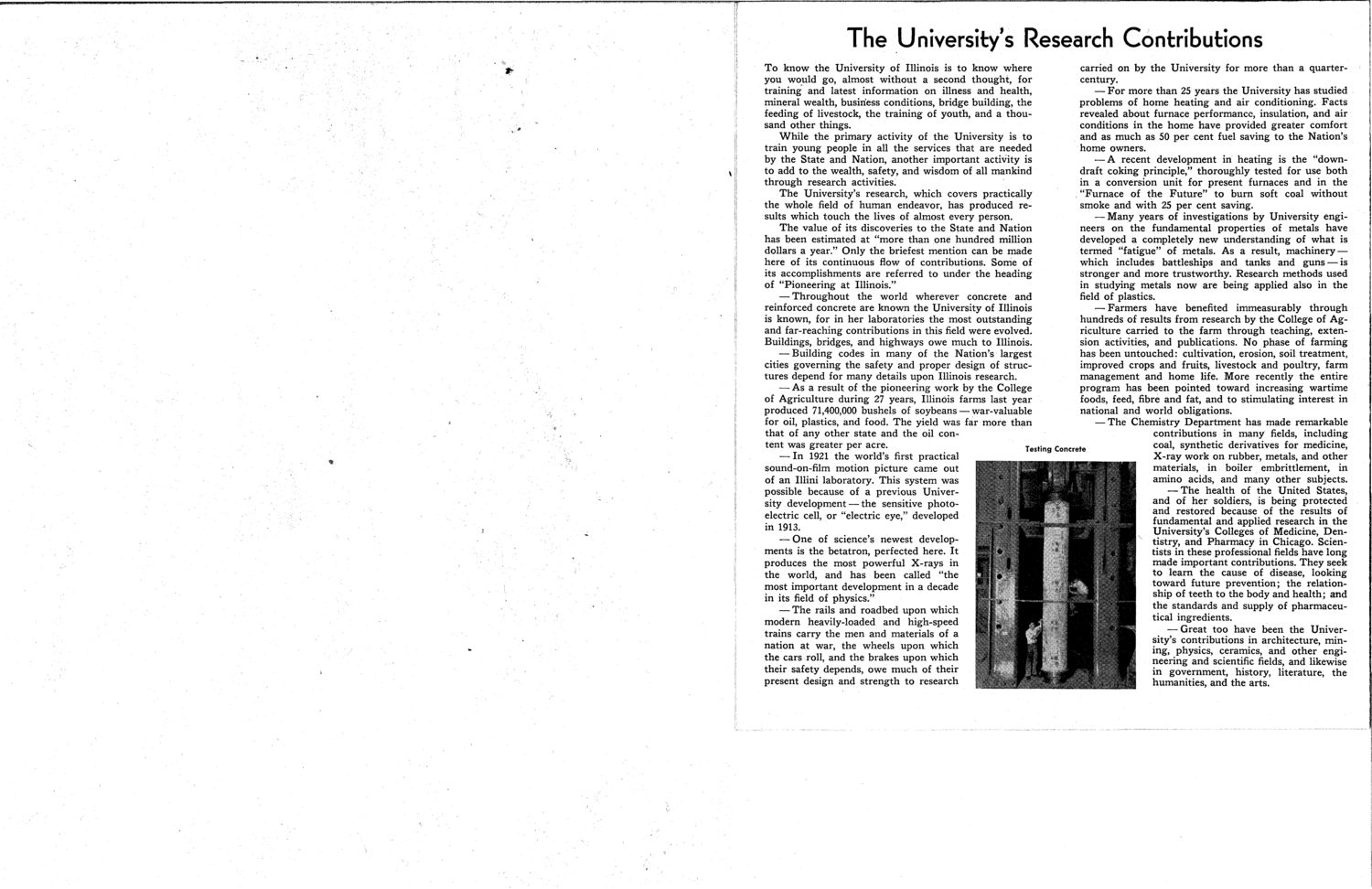| |
| |
Caption: Booklet - Welcome to the University (1945)
This is a reduced-resolution page image for fast online browsing.

EXTRACTED TEXT FROM PAGE:
The University's Research Contributions To know the University of Illinois is to know where you would go, almost without a second thought, for training and latest information on illness and health, mineral wealth, business conditions, bridge building, the feeding of livestock, the training of youth, and a thousand other things. While the primary activity of the University is to train young people in all the services that are needed by the State and Nation, another important activity is to add to the wealth, safety, and wisdom of all mankind through research activities. The University's research, which covers practically the whole field of human endeavor, has produced results which touch the lives of almost every person. The value of its discoveries to the State and Nation has been estimated at "more than one hundred million dollars a year." Only the briefest mention can be made here of its continuous flow of contributions. Some of its accomplishments are referred to under the heading of "Pioneering at Illinois." — Throughout the world wherever concrete and reinforced concrete are known the University of Illinois is known, for in her laboratories the most outstanding and far-reaching contributions in this field were evolved. Buildings, bridges, and highways owe much to Illinois. — Building codes in many of the Nation's largest cities governing the safety and proper design of structures depend for many details upon Illinois research. — As a result of the pioneering work by the College of Agriculture during 27 years, Illinois farms last year produced 71,400,000 bushels of soybeans — war-valuable for oil, plastics, and food. The yield was far more than that of any other state and the oil conTesting tent was greater per acre. — In 1921 the world's first practical sound-on-film motion picture came out of an Illini laboratory. This system was possible because of a previous University development — the sensitive photoelectric cell, or "electric eye," developed in 1913. — One of science's newest developments is the betatron, perfected here. It produces the most powerful X-rays in the world, and has been called "the most important development in a decade in its field of physics." — The rails and roadbed upon which modern heavily-loaded and high-speed trains carry the men and materials of a nation at war, the wheels upon which the cars roll, and the brakes upon which their safety depends, owe much of their present design and strength to research carried on by the University for more than a quartercentury. — F o r more than 25 years the University has studied problems of home heating and air conditioning. Facts revealed about furnace performance, insulation, and air conditions in the home have provided greater comfort and as much as 50 per cent fuel saving to the Nation's home owners. — A recent development in heating is the "downdraft coking principle," thoroughly tested for use both in a conversion unit for present furnaces and in the "Furnace of the F u t u r e " to burn soft coal without smoke and with 25 per cent saving. — Many years of investigations by University engineers on the fundamental properties of metals have developed a completely new understanding of what is termed "fatigue" of metals. As a result, machinery — which includes battleships and tanks and guns — is stronger and more trustworthy. Research methods used in studying metals now are being applied also in the field of plastics. — Farmers have benefited immeasurably through hundreds of results from research by the College of Agriculture carried to the farm through teaching, extension activities, and publications. No phase of farming has been untouched: cultivation, erosion, soil treatment, improved crops and fruits, livestock and poultry, farm management and home life. More recently the entire program has been pointed toward increasing wartime foods, feed, fibre and fat, and to stimulating interest in national and world obligations. — The Chemistry Department has made remarkable contributions in many fields, including coal, synthetic derivatives for medicine, Concrete X-ray work on rubber, metals, and other materials, in boiler embrittlement, in amino acids, and many other subjects. — T h e health of the United States, and of her soldiers, is being protected and restored because of the results of fundamental and applied research in the University's Colleges of Medicine, Dentistry, and Pharmacy in Chicago. Scientists in these professional fields have long made important contributions. They seek to learn the cause of disease, looking toward future prevention; the relationship of teeth to the body and health; and the standards and supply of pharmaceutical ingredients. — Great too have been the University's contributions in architecture, mining, physics, ceramics, and other engineering and scientific fields, and likewise in government, history, literature, the humanities, and the arts.
| |